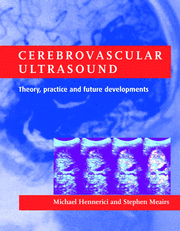Book contents
- Frontmatter
- Dedication
- Contents
- List of contributors
- Preface
- PART I ULTRASOUND PHYSICS, TECHNOLOGY AND HEMODYNAMICS
- PART II CLINICAL CEREBROVASCULAR ULTRASOUND
- (i) Atherosclerosis: pathogenesis, early assessment and follow-up with ultrasound
- (ii) Extracranial cerebrovascular applications
- (iii) Intracranial cerebrovascular applications
- 18 Transcranial Doppler ultrasonography and vasospasm after subarachnoid hemorrhage
- 19 Intracranial cerebral artery stenosis and occlusion
- 20 Arteriovenous malformations
- 21 High intensity transient signals
- 22 Transcranial Doppler monitoring during carotid endarterectomy
- 23 Cerebral vasoreactivity
- 24 Intracranial venous diseases: the role of ultrasound
- PART III NEW AND FUTURE DEVELOPMENTS
- Index
24 - Intracranial venous diseases: the role of ultrasound
from (iii) - Intracranial cerebrovascular applications
Published online by Cambridge University Press: 05 July 2014
- Frontmatter
- Dedication
- Contents
- List of contributors
- Preface
- PART I ULTRASOUND PHYSICS, TECHNOLOGY AND HEMODYNAMICS
- PART II CLINICAL CEREBROVASCULAR ULTRASOUND
- (i) Atherosclerosis: pathogenesis, early assessment and follow-up with ultrasound
- (ii) Extracranial cerebrovascular applications
- (iii) Intracranial cerebrovascular applications
- 18 Transcranial Doppler ultrasonography and vasospasm after subarachnoid hemorrhage
- 19 Intracranial cerebral artery stenosis and occlusion
- 20 Arteriovenous malformations
- 21 High intensity transient signals
- 22 Transcranial Doppler monitoring during carotid endarterectomy
- 23 Cerebral vasoreactivity
- 24 Intracranial venous diseases: the role of ultrasound
- PART III NEW AND FUTURE DEVELOPMENTS
- Index
Summary
Introduction
Although insonation of cerebral veins in adults was attempted early in the 1990s (Hennerici, 1990; Mitchell, 1990; Furuhata, 1989), the intracerebral venous system has long been thought to be mostly inaccessible to transcranial sonography, due to its limitations in detection of low flow velocities, difficulties to separate these small signals from arterial ones and artefacts, poor angles of insonation and due to the high anatomical variance of the intracerebral venous system. In particular, the detection of cerebral veins and sinuses is difficult with conventional pulsed Doppler handheld probes, as the topography is concentrated along the midline structures and near the skull. In addition, venous diseases of the brain are much rarer than arterial diseases and treatment strategies are widely controversial (Bousser et al., 1985; Bousser & Russell, 1997).
New developments in ultrasound technology, particularly the introduction of transcranial colour-coded duplex system analysis and echocontrast enhancement have reduced some of these limitations and at least facilitated the analysis of intracerebral venous blood flow conditions. Using standard insonation pathways, venous signals can be identified from midline deep cerebral veins and some of the large draining sinuses from a transtemporal approach. The jugular vein and the sigmoid sinus including brainstem draining veins may be recorded from a transnuchal approach and the ophthalmic vein and the orbital draining plexus from a transorbital approach (Fig. 24.1). Normal flow velocity values are highly variable due to the diversity in topographic anatomy and also from variancies of insonation angles.
- Type
- Chapter
- Information
- Cerebrovascular UltrasoundTheory, Practice and Future Developments, pp. 335 - 338Publisher: Cambridge University PressPrint publication year: 2001



